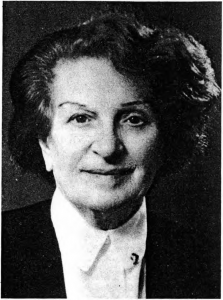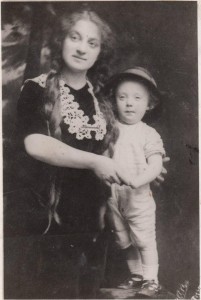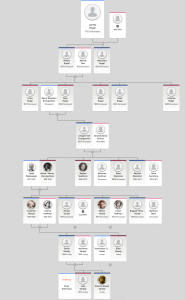I look for them in the past and I find their remains, enough to resemble a person, even someone whose passions I can identify more than vaguely with my imagination. Again, I have this feeling that the historical researcher is more than part necromancer. Not only do we create with meaning, but we also revive with our devotion to enliven. The magical praxis demands a gathering of every bit of surviving evidence. I’ve pieced what I’ve can together, and I return to this page to add more detail as I can find and collect in free-without-fee genealogical databases courtesy of JewishGen.org and the Church of Latter Day Saint’s FamilySearch.org.
Little is certain — a family legend has it that at some point, the name Varady was adopted by ancestors named Weisenberger or Weinbecker. (Some resolution to this mystery has been detailed here.) This however, is the story of my great-grandmother Helen‘s younger sister who was born Regina Szabolcsi.
She was born 27 Nov 1885 to my great-great grandparents Chaim Volf Zwangschein and Ghinendel “Nina” Ehrlich (spelled Mina in my great-grandmother’s death record) in Nagyvárad (now Oradea, Romania). In 1883, Chaim Volf (from Gyüre, Hungary) Magyarized his name to Farkas Szabolcsi. He’s sometimes listed as a grocer, a peddler, or a merchant.
Nina was born in Tolcsva, near the border of Galicia. I think she may have had a sister, by nature of an interesting coincidence I discovered:
A woman, Irma Ehrlich, was married to Rabbi Armin Rosenberg, the first Chief Rabbi of the Nagy Fuvaros Street Synagogue according to a history of Budapest synagogues. After several children died young, in 1897, Armin and Irma took a ship and settled in Brooklyn. A few years later in 1903, my great-grandmother Helen, joined them there. Later on, Armin, now a cantor at Beth Israel in Philadelphia married her over to my great-grandfather Joseph Varady, a Hebrew carpenter and socialist, also from Nágyvarad.
Helen’s 1903 emigration record tells me she was a dressmaker whose last residence was Paris. I imagine her learning to sew magnificently fancy dresses for ritzy Austro-Hungarian balls. Regina, we learn, was also a dressmaker. Perhaps their mother Nina was as well. Her husband, my great-grandfather Joseph had a step-father from the age of 3 who was also a dressmaker, Samuel Kohn. Perhaps he introduced them back in Hungary?
A digression: We find Helen returning to the United States from Vienna via Trieste in 1908 where her occupation is now listed as housekeeper. Later on, we find her returning to the US again, this time at the very outset of WWI via Liverpool in 1914. Had my great-grandmother returned to Europe to work or live with family while my great-grandfather Joseph Varady continued working in the US in order to send back money to her in Europe? Plausible. No one knows. In the Bureau of Investigations report on Joseph from 1918, we find him in possession of I.W.W. pamphlets and part ownership in a cooperative farm in Ruskin, Florida. He’s accused of being a spy while working at the U.S. Navy shipyard in Charleston but is cleared. The story is ridiculous. A month later, he’s arrested for smuggling liquor through the mail from a friend in New York City in an empty boiler. He builds his own house in Yardley, Pennsylvania and he or his boys participate in a Jewish farm school.
I can’t know for certain when Regina arrived. More research is needed. Is she the Regina Sunshine shown in the 1910 Census to be living in a Chicago boarding house with a number of other single women? Where did she come by the name Sunshine. There is a man — Sam Sunshine. On his 1942 Naturalization record, it appears his previous name was Samuel Szabolcsi, from Nagyvárad, Hungary. His immigration record notes that Yosef Varadi is his cousin (!), but probably we think just means that he’s his brother-in-law. Sam Sunshine is Reggie and Helen’s younger brother, born in 1892. Sunshine is an anglicization of Zwangschein. But there’s also another sister, born in 1888 — Roza Szabolcsi, of which our family has no memory; is she the Reszi Sunshine that the family knows and if so, then who is her older sister? Her birth year matches more closely what is provided in her eulogy (see below). Is that her residing in a Manhattan boarding house with other single women in the Census of 1920?
- 1954, with her grand-nephews
- 1954, with her nephews
- 1954, with her nephews wives
- New Regionalist style poster after Thomas Hart Benton, circa 1953. Can anyone identify the artist or painting?
In the photos above we can see her sitting with her nieces and nephews, my grandfather and his brothers, my father and aunt and his cousins. The painting behind them (by Thomas Hart Benton or someone else in the New Regionalist school?) looks incredible and I’d love to be able to see its entirety and in color. A family story tells us that these photos were taken before Regina traveled to Paraguay where she was a Bahá’í missionary…
Thankfully, my Aunt Ellen, writes to the National Bahá’í Archives, where an archivist responds with some precious information. Here we go.
This is what we learn from The Bahá’í World Record v.15 (Year 125, 126, 127, 128 and 129 of the Bahá’í era) 1968-1973 (Bahá’í World Centre, Haifa 1976) which contains a record of eulogies for its missionaries. The following was written by Ellen Sims.

REZSI SUNSHINE 1888-1970
SADDENED NEWS PASSING REZSI SUNSHINE
DEVOTED CONSECRATED SERVANT BLESSED
BEAUTY STOP PRAYING DIVINE THRESHOLD
PROGRESS SOUL ABHA KINGDOM.
Thus read the cable from the Universal House of Justice about Miss Rezsi Sunshine who ascended to the Abhá Kingdom on March 6, 1970, at the age of eighty-two, after having served tirelessly as a pioneer in the first and second Seven Year Plans, and the Ten Year Crusade of the beloved Guardian, and later in the Nine Year Plan given to the Bahá’í world by the Universal House of Justice.
Little is known of her early years save that she emigrated to the United States from Hungary when she was sixteen years old. She began her hew life as a seamstress in New York City and later became an established modiste, creating expensive and elegant gowns for wealthy society women of the area. Many years later she laughingly recalled that when she pioneered in the Middle West she was offered only a dollar or two to make simple cotton summer dresses.
In New York she met Miss Jean Silver, her spiritual mother. There was an immediate attraction and affinity between them. Both were the daughters of rabbis and they had like characteristics of enthusiasm, devotion, independence and radiance of spirit.
In 1938, responding to the call for pioneers in the virgin States in the first American Seven Year Plan, Rezsi went to Arkansas and taught in Hot Springs and Little Rock. She continued pioneering in that area throughout the second Seven Year Plan.
During the Ten Year Crusade, in 1955, she pioneered to Bolivia and largely through her constant teaching efforts, the Spiritual Assembly of Cochabamba was formed at Ridván 1956, the fourth Assembly in the country.
From 1959 until 1963 she spent three and a half years in Paraguay, teaching in Villarica, Pedro Juan, Encarnación and Concepción. Her most notable contribution in this period was the establishment of a Spiritual Assembly in Concepción in 1962. She also served as a member of the first National Spiritual Assembly of Paraguay.
Returning to her beloved Bolivia, she settled in the little city of Tarija near the Argentinian frontier. In 1967 the first Spiritual Assembly of Tarija was elected. She wrote to the Bolivian National Assembly before leaving for that post: “Indeed, I am all poised for Tarija. What a great privilege to start out again on another Divine adventure for Baha’u’llah! Can we ever be grateful enough?”
Finally, in 1970, Rezsi, so capable in opening up virgin places, offered to pioneer in San Luis, Argentina. She left Bolivia in January of that year, but her pioneer mission had now ended and she passed away in Cordoba, Argentina, on March 6.
This account of Rezsi’s service would be incomplete without a reference to her unique personality. She embodied the teaching “Be unrestrained as the wind, while carrying the Message …” and “Let God be all-sufficient for thee. Commune intimately with His Spirit and be thou of the thankful…” Rezsi lost no opportunity to give the Glad Tidings. She would meet people at all hours, considering no one as a stranger. She taught in the parks, in the shops, in the markets, and in any byway in which she happened to find herself. Her hospitality and generosity are well remembered.
Everyone’s sad story affected her heart; she wanted to feed and clothe all the poor, tend and heal all the sick. She took no thought of the morrow as she freely used her small resources for the Faith, for the needs of others and for purchasing great quantities of Bahá’í literature which she presented as gifts to anyone who would accept. The dynamic qualities of this dedicated pioneer can best be glimpsed through a few incidents told about her. A North American pioneer who accompanied her on a journey to Encarnación, Paraguay, recounts:
“We registered in a small hotel in the late afternoon. Rezsi would not rest for a moment. She wanted to start out immediately to look for a local Bahá’í centre. It was almost sunset as we walked down a long hill to a little plaza near the river. There, seated on a bench, we recited the Tablet of Ahmad. When we finished, Rezsi asked whether I had stood before her during the prayer; when I replied that I hadn’t she explained that she had felt some Presence in front of us. Then she rose and said decisively, ‘Now we will walk to the corner.’ At the corner, ‘Turn left’. In the middle of the next block we were led to a perfect little modern house, ideal for a centre. Rezsi paid the rent, purchased a mattress, and moved in immediately. No one had more faith in Divine Guidance than Rezsi Sunshine. That little house served as the local Bahá’í centre for the next several years.”
A Bolivian believer relates that she unexpectedly found herself in Tarija without any idea as to where she could locate Rezsi. Attracted by the music of a street fiesta she paused and discovered Rezsi, whirling and dancing like a young senorita, an eternally youthful spirit in spite of having already passed her eightieth birthday!
Sr. Athos Costas, a member of the Continental Board of Counsellors in South America, has written: “Rezsi Sunshine lived only for the Faith and freely gave the Teachings to all who crossed her path. We still meet people who remember her with love and who received the first words about Baha’u’llah from her. A month before her passing, I visited Tarija. I found it very difficult to follow her in every direction as she took me to meet her numerous friends. In that one week, we had seven Bahá’í meetings. She spoke with enthusiasm about her transfer to San Luis, Argentina. As she spoke, she told me that she saw the face of ‘Abdu’l-Baha before her.”
Only a special event could take Rezsi away from her pioneer post even for a few days. One of the brightest moments of her last years was the visit of the Hand of the Cause of God Amatu’l-Baha Ruhiyyih Khanum to Bolivia in 1967. As Rezsi entered the National Bahá’í Institute in Cochabamba she was overwhelmed at the large gathering of Bolivian friends and pioneers and recalled her early efforts to teach some of the first Bolivian believers. With tear-filled eyes she repeated the Greatest Name over and over again and expressed praise and gratitude to Baha’u’llah. She returned to Tarija and never left again to attend any other Bahá’í event in Bolivia.
Such precious pioneers as Rezsi Sunshine cannot be described. They are like quicksilver which children try to touch and cannot catch or hold. We can only be grateful that we have known briefly some of these indefatigable servants. As the Guardian said frequently of such dedicated ones after their passing: “Their services are unforgettable.”
Click to access Rezsi-Sunshine.pdf

“Reszi Sunshine (1885-1970)” is shared by Aharon N. Varady with a Creative Commons Attribution-ShareAlike 4.0 International copyleft license.







Leave a Reply